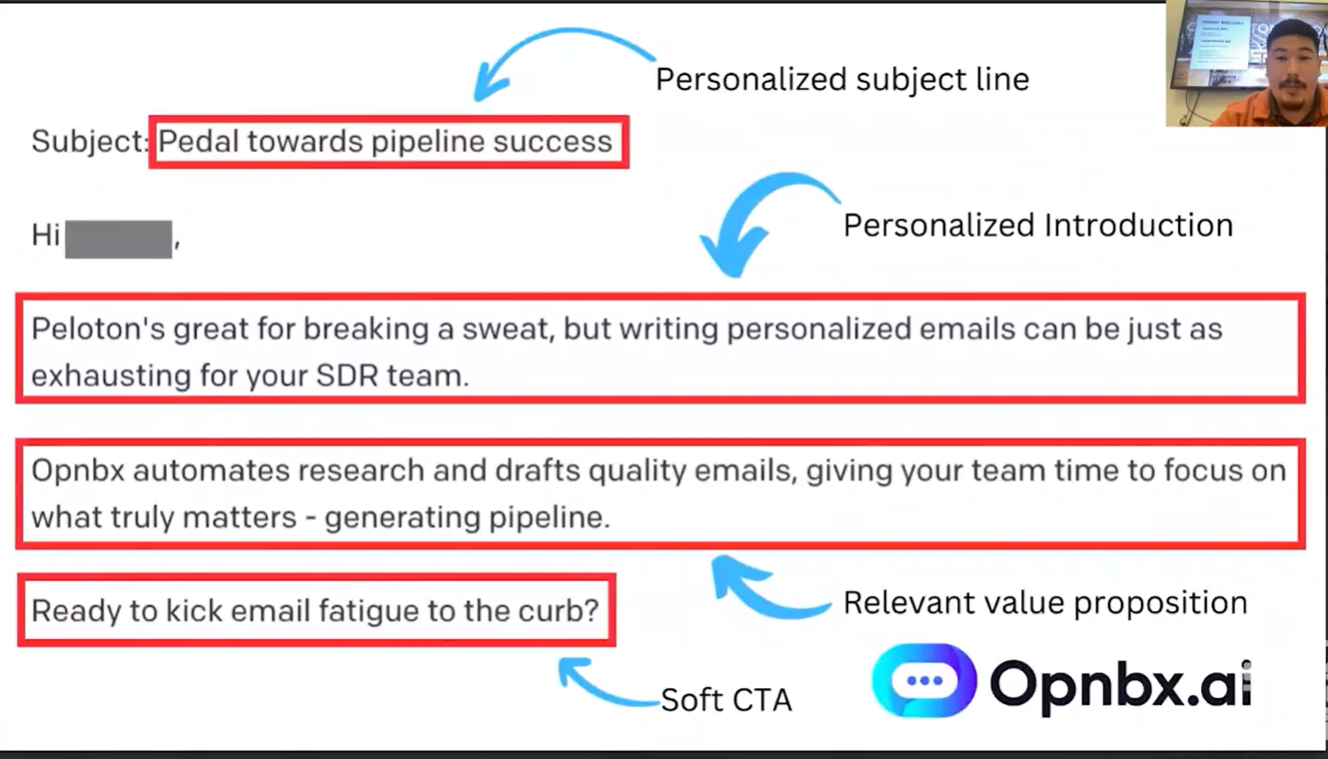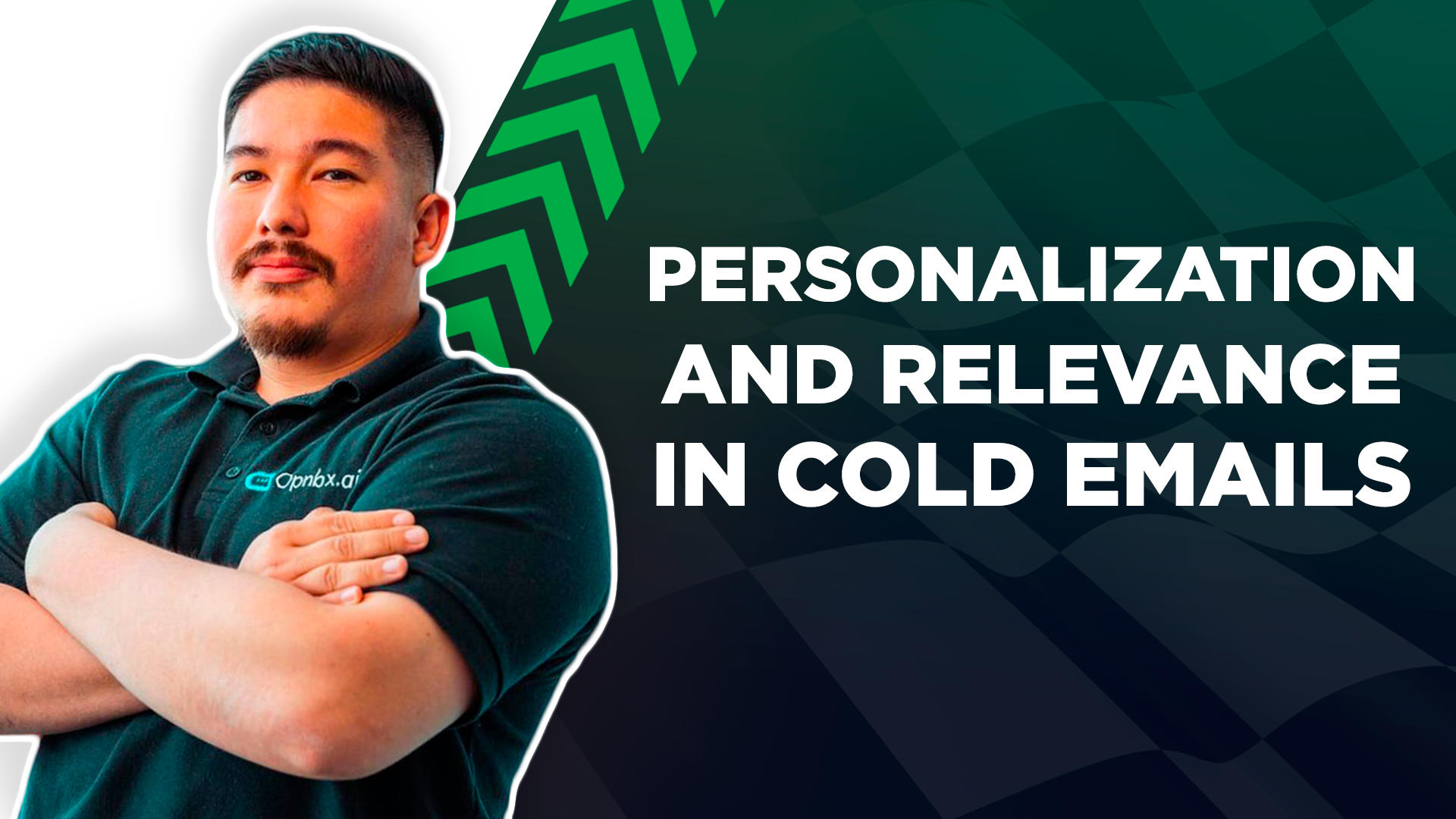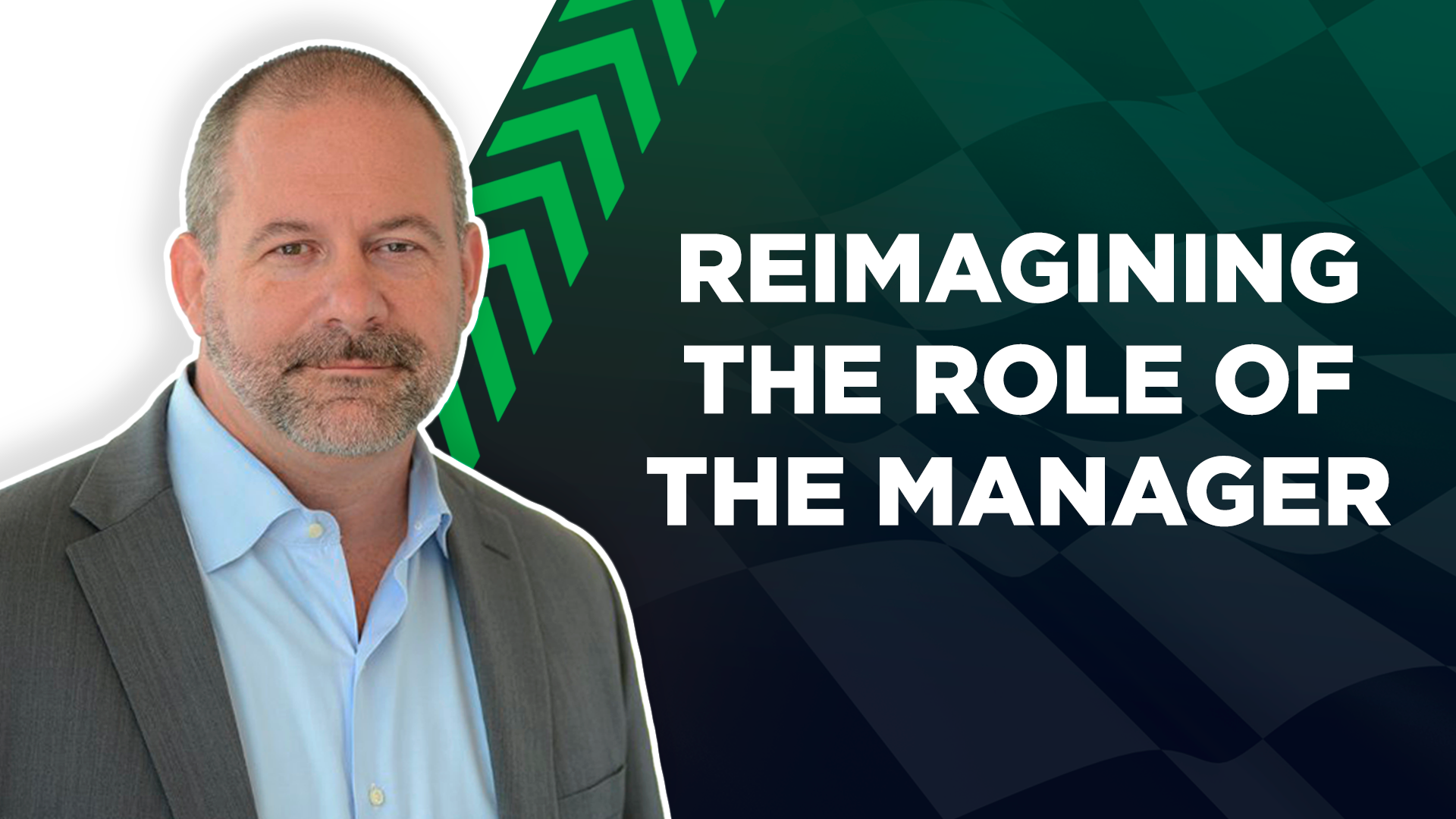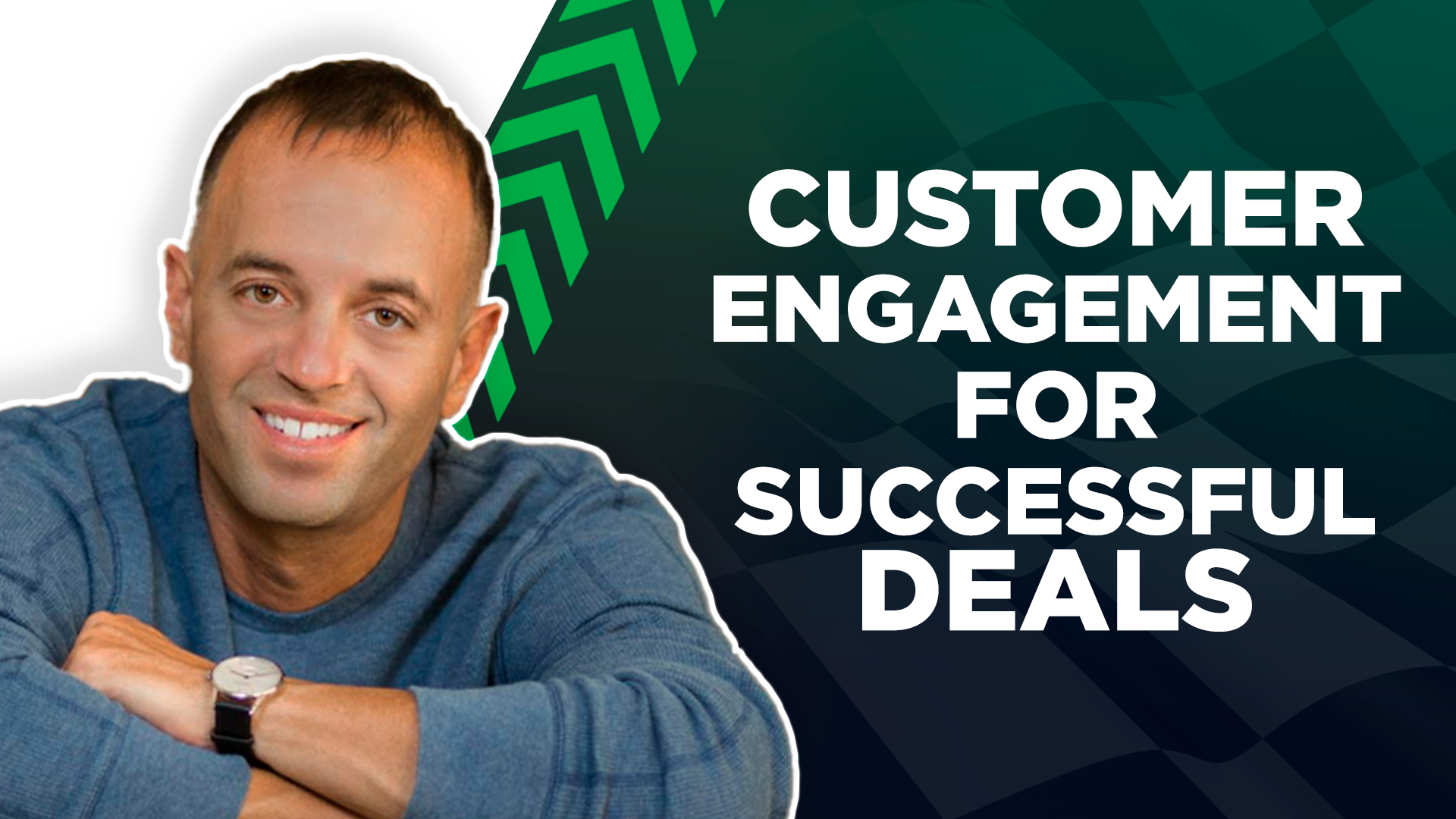Table of Contents
Personalization and Relevance in Cold Emails
In episode 79 of Pit Stops to Podium, we sit down with George Suarez, the Founder and CEO of Opnbx.ai, a cutting-edge platform that assists sales representatives in quickly crafting personalized emails. With a dedicated team focused on enhancing sales efficiency, George brings valuable experience in the sales technology industry.
During our conversation, we explore the crucial topic of personalization and relevance in cold emails. George shares insights on transforming any cold email into a personalized and relevant communication, highlighting the differences between personalization and relevance in sales communication. We also delve into the power of relevance in making cold emails significant to prospects. By leveraging technology and AI, George reveals effective strategies to capture the attention and interest of potential clients, ultimately improving sales efforts.
If you’re ready to learn from one of the best, then buckle up and hold on!
Pitstop Highlights
The Difference Between Personalization and Relevance
These definitions have changed over time. At one point, personalization was just putting someone's first name in an e-mail. But nowadays, personalization is all about how someone connects to your solution.
Relevancy allows you to "have an eye inside someone's organization" and see how they operate. This allows you to create much better ICPs.
The Importance of Structure, Length, and Engagement
No one wants to read a long e-mail. Good e-mails are easily digestible and attempt to simply start a conversation.
Showcase of Personalization for Structuring Effective Emails

Leveraging AI Technology as a Sales Tool
The best AI tools are the ones that are able to bring together human emotion and expertise and AI.
Connect with George
Website: https://www.opnbx.ai/
LinkedIn: https://www.linkedin.com/in/george-suarez-b27559174/
Full Transcript
Brendan: Hey everyone, welcome to Pit Stops to Podium, The RevPartners podcast where we talk to execs who compete and won in taking companies from high growth to high scale. My name is Brendan Tolleson. I serve as the co-founder and CEO of RevPartners, and I'm delighted to have with me today, George Suarez, for this episode of Pit Stops to Podium. Welcome, George.
George: Thank you for having me, here excited to meet all of you at some point and more.
Brendan: Yeah, well, hey, we're excited to have you. Even as we were talking in the prep, I know you just made a recent move from California to Tulsa. So I don't know what was in your background, but I'm sure you're adjusting to this new normal of heat and no water.
George: Yeah, definitely. It's definitely really flat compared to California, especially from those hills in San Francisco. But luckily, I don't have to go up them every day.
Brendan: Well, you know, as we're getting, as our audience get to know you, George, for those, for those who may not know, you serve as a founder and CEO of Opnbx. And I think this is a great opportunity for you to shed a light on what you do and a little bit of the background of how you started Opnbx and why. So the floor is yours.
George: Yeah, I mean, that's a great question. You're probably wondering what the heck is Opnbx AI. But essentially, I've been looking at the trends in the industry and the market. What's going on right now? We see all these massive layoffs. We're seeing companies getting these high pressure from VCs to hit these annual goals still, but with less resources, less people as well. It's like, how do people manage to do this at the same quality with less people and resources? So. The reason why I built Opnbx is to help sales leaders hit their quarterly goals, their annual goals, by enabling their SDRs to essentially replicate their success. So if an SDR is really good at writing emails, how can we enable them to be five times better, five times faster, five times the output that they normally do? Therefore, instead of hiring a bunch of SDRs when you don't know what you have to do, like up-ramping them, if they're even gonna hit their goals. you are just replicating what's already working. Essentially what we do is we help sales reps replicate the standard of personalization in your organization and we help them do that by automating their research and allowing them to Convert from becoming writers into more editors. We've noticed that most sales reps aren't always the best copywriters and because they have to be focused on so many things So what we do here at Opnbx is simplify their email channel. So all they have to focus on is getting more conversations.
Brendan: Yeah, I think it's great. I mean, it did. Look, there's a to your point about the macro theme that there's a lot around do more with less. And so the idea of increased productivity makes a lot of sense. You know, when we think about growth, there are really two ways to impact the flywheel. There's increasing force, which is applying more pressure with people or resources or you decrease friction and a lot of what you're talking about, it's really how do we eliminate friction in the process to allow for those people that are that are there to be more effective and efficient. to drive that productivity. So that's really cool. And I'm assuming you have some background in the SDR seat that gives you a unique lens into the day in the life, correct?
George: Yeah, exactly. I mean, in this market, inboxes are noisier than ever, especially with people keeping their money closer to their chest they don't want to spend. So their prospects are getting hundreds of emails every single day. And if it's not personalized, it's not relevant to them, they're not even going to open it. And if the item is not even digestible, they're not even going to read it. So our purpose is here is to ensure that we're keeping the research, we're doing the standards of personalization for you. How I came up with this, I was an SDR myself, and I noticed that every week I would send a thousand emails because I had to hit my KPIs, but maybe I get one response if I was lucky, and it normally wasn't a positive one. It was someone telling me to F off because it wasn't relevant. So after learning that advice, I realized that the best emails that were being responded and were converted into pipeline were the ones that people were doing industry research on. They were looking at financials, 10Ks, reviews, earning calls, podcasts from a high position. CEO, people talking about product launches, job postings, and they were able to tie that information into a personalized email where they showed how they could add value to that organization. But the problem with that is that it wasn't scalable. I mean, a lot of newer SDRs, they don't know how to do that level of research like an enterprise account executive. They're still learning how to be themselves at the same time. They're learning about the market, who the competitors are. So it's just not scalable. I mean... Some reps typically spend anywhere from 20 to 30 minutes. And as you can see, like doing that for four emails a day, that's two hours out of your day for maybe not even getting a response. So people are having to battle with that trade-off of like, how can we reach as many people as we want, but how can we be quality at the same time? So once I realized that was a problem, I wanted to build a solution that can help STRs like me at that time, speed up that research, replicate our account executives, be able to send out emails at are the highest standard of personalization that's working at our organization.
Brendan: That's great. Well, I love people that see problems and don't wait for others to create it, but really take the onus on themselves to create a solution for it. And it generally is tied to something that you are connected with or have experience in. So kudos to you for building that. Well, let's, George, before we dive in a little bit more into what kind of lessons you've learned from prospecting that we can teach our audience, before we do that, let's get to know you a little bit outside of work. So what are those? passions, hobbies, interests that our audience should know about you.
George: Yeah, I mean, I'm a huge family person. I like spending time with my parents as much as I can. My friends, I love being able to travel as much as possible, being able to work remote. That's one of the beauty things that, you know, the COVID brought to us. So I'm thankful for at least that, seeing the positives in life. Yeah, I just love soccer, love watching Manchester United, boxing. Those are some of the things that I do in my free time.
Brendan: It's been a rough go for Man U, but you know, it's, I mean, actually not having a bad year this year, but Man City has seemed to be taking the table, although we'll see what them in Arsenal at the end of this season. But well, I appreciate you sharing a little bit more on just who you are outside of work. It's always important to have that perspective knowing that we are human beings after all. So George, let's get back into a little bit you were already kind of teasing out. And as we talk about, hey, how do we do more with less? How do we make these? SDRs or even AEs depending on who's doing the prospecting more productive. You talked a little bit about personalization and relevance and I think a good place to start is just that definer because for some people they may see what's the difference between personalization and relevance. So help our audience understand that distinction.
George: Yeah, I mean, this is this is a confusing topic for a lot of people because definitions change over time. I mean, what did personalization mean back then back then and meant putting someone's name in the company that they work for. Right. So that's what a lot of people are still stuck in. They think by just putting someone's name and categorizing it by ICP, that it should be relevant, but it's not. But what personalization really is nowadays is how does someone connect to your solution? Like, for example. If I know an STR manager that she's talking about how her responsibilities are to ramp her team, they're able to ensure that their reps are always learning and hitting their quotas, I know I can talk about topics that are relevant to that because that's something that she's in charge of. So I'm being personalized because I found that in her account and I know that it's something that she's responsible for so I can target her about that. And then when it comes to relevancy, I love using relevancy in a different way. And what I mean by that is finding those 10Ks, finding those financial reports, finding those product launches, job postings. Job postings for me are one of my favorite points of relevancy because essentially it allows you to have an eye inside the organization, how they operate, what type of tech stacks they're using, what those roles responsibilities are. based off those roles responsibilities, you're able to create your ICPs more, a lot better to truly understand why you're targeting that company versus like another company, they might have the same roles, but they have different responsibilities. So being able to understand what personalization is and relevancy can really take your outreach to the next level, especially in today's market where inboxes are noisier than ever. you know, we're programmed to see anything and just delete it, especially if it's not just looking at a subject line.
Brendan: Yeah, so to summarize some of that, like the personalization is more relevant to the individual. Relevancy is more tied into something that's going on within the industry, the company or like in their department. And so is that a fair way to kind of summarize that?
George: Yeah, I mean, would you be open for me to show you an example of how people can use personalization?
Brendan: Yeah.
George: Let me share my experience. Let's see. Perfect. So as you can see on my screen here, I use an SDRs manager's about section, and she mentions how she likes to use her Peloton whenever she has time, right? So right here, I use relevancy based off not only her love of using the Peloton, but her job being responsible for ensuring that her reps are generating as much pipeline as possible to make their CROs happy. So right here, I put pedal towards. Tourist pipeline success. Peloton's great for breaking a sweat, but writing personalized emails can just be as exhausting for your SDRs team. So I'm making that connection of like, hey, I know how much you love writing Peloton, but it is exhausting. It's just as exhausting for your SDRs. It feels like an exercise that they don't wanna do. Working out sucks, but if you figure out a way to make it enjoyable, people can have a repeatable process. So right here, now I wanna go into how my... you know, tool is relevant towards her job. So it says, open box automates research and drives to high quality emails, giving your team time to focus on what truly matters, generating pipeline. And then right here with my soft CTA, instead of asking for a meeting time, I'm asking for a conversation to see if she's even interested and potentially seeing if it's something that can help her. So it says, ready to kick email fatigue to the curb. So I'm making it funny. But here's an example of what personalization would be using her account for LinkedIn about section. But if you wanted to make this more interesting, I would use something like, you know, job listing. For example, if an SDR manager is posting that she's hiring three more STRs, normally that's an indicator for me that they're looking to add more pipeline into their goals to hit their annual goals, right? So what that means to me, it's like, hey, instead of an SDR manager hiring, you know, you know, 60K base and 40K commission paying for healthcare benefits, paying for insurance and other tech stacks. She can invest an X amount of dollars into a tool that can help her reproduce, get more exposure from her current team that already knows about the industry, they're already ramped, and they can be producing more emails that typically will generate more pipeline for a fraction of the price that it would cost one STR. So that's how I would use. irrelevant information from like a job post or maybe it's the CEO talking about how they just raised funding and they want to go to, they want their next stage is to generate, you know, double the revenue that they did last year. That for me is give me an indicator that they're going to be working on the revenues. From there, I can look into their ICPs and see what each role is responsible for and send more of a targeted message for their responsibilities.
Brendan: It reminds me of there's a sales coach, Jeff Hoffman, who you may know. But his whole framework is the why you, why now. And so to me, that's the relevancy aspect of connecting those two concepts of why does your solution solve a problem or unlock an opportunity that the prospect has. And even the way you framed it, that For those that may not have seen the screen, the first paragraph is around the company or the individual, and the second paragraph is around the solution. And so I think one of the benefits of that, I mean, personalization is you use a Peloton line. That's a clever, to your point, it's a clever way to create connection. The relevancy is a really powerful way to drive urgency. Is that how our audience should think about, like how relevancy can be a- a benefit not only to create a response, but really to drive momentum with a deal.
George: Yeah, I mean the beauty of an email, the ones that work the best are the ones that are able to be personalized, relevant and timely like why you why now? Like just like how you explain it's like why is this relevant information important to me now? You can justify it based off a quarterly report, a product launch, you know, job posting. My subject line was kind of funny. I was talking about Peloton. I mean if you have over 100 emails in your inbox. you know, being able to connect with an email, just seeing Peloton, it's a pattern interrupt. It's something different, but they're probably not gonna be used to seeing. Normally, they're probably gonna be saying, hey, like, let's generate more pipeline. Are you reaching your goals, X, Y, Z? It's a pattern interrupt where the SDR manager can be like, oh, wait, this is different. Let me click on it. And then making that email digestible, as you can see in that example, it wasn't a lot of text. It was under 55 words where they were able to skim it first and then... potentially read and if it was interesting then they can book that meeting.
Brendan: Yeah, I think that's an important point to make as we conclude, which is, you talk about the pattern disruption, but there's also, with subject line being different, but also how you structure, or the length rather of the email, you said it was about 55 characters. I feel like oftentimes sales reps feel like, it's a good reminder, less is more. And oftentimes there's this feeling that I have to sell them on one email and it's just like that actually works to your disadvantage. I can't tell you how many times I get emails that are four or five paragraphs. And it's just like, to your point, people scan emails at this day and age and they're reading on their phone. So if you are creating that type of structure, it's not gonna be a good outcome.
George: Yeah, I mean, also those executives are tired from a long day. They're not going to want to read this huge email after working long hours, right? So making it as easy as possible for them to digest that information and see if it's even relevant, not asking directly for an email, just starting a communication, a conversation to see if it's something that they're working on works wonders. I mean, if that conversation takes three, three, three emails back and forth, that lands you a meeting. I believe it's worth it.
Brendan: Yeah, and are you, you know, you talked a little bit about, you know, the volume game versus like quality. If I heard you right, some of the benefits of open boxes that allows for you to maintain a volume, maybe something one-to-one of there's a mass, but you're still getting some bit of the volume while also balancing relevancy and personalization. Is that how we should think through that?
George: Yeah, I mean the email example that I show you that was generated from Opnbx ourselves, like we legit took someone's profile, we created personas in our system, listing the pain points that an SDR manager has and how we provide value to them in our system uses that information to generate a personalized email that's relevant to that person every single time in a fraction of seconds versus a rep spending, you know, 30 minutes getting that research and then writing them themselves. We create a scalable process for them. to be able to hit a standard of personalization every single time.
Brendan: Yeah, it's interesting too. And there's a lot of talk around AI and if that's like something to be worried about, and I don't know how much you're using AI right now, but to me, it's like, this is a great example of how AI can be a tool. And it's not, and use that rep example. It's really more of, do you understand what questions to ask and let AI do that work in the background and so it's been a 20 to 30 minutes getting that information. Just knowing what you should be asking for, and then letting that work in the background to your benefits so you can be more productive.
George: I mean, if you look at a lot of AI, people are scared of it. But where stage edit is right now, what I've seen, they're like essay generators. I mean, they have all this information, but they don't know what direction to go because they're not experts. They're not the people who do research and why your tool is going to help them. So the best AI tools that I've seen in the market are the ones where they're the human and the AI are able to collaborate together and use the human emotion. Use. the industry expertise and see, and then have AI just replicate essentially what the best practices are using the information that you give.
Brendan: Yeah, the way that Yamini, the CEO of HubSpot, talks about it is it's a combination of AI plus that last mile of human intelligence. And it's really that interpretation layer and the direction that make it a very powerful solution. All right, well, George, as we wrap up, if our audience wants to learn a little bit more about you or Opnbx, what's the next step they can take?
George: Yeah, a great place to connect with me would be on LinkedIn. Would love to chat with any of you on there. If you want to learn more about emails, I'm always posting educational posts on how to be more relevant and personalized and timely in today's market.
Brendan: I love that. Personalization, relevancy, and timing. So as our audience is looking through, how do we continue to drive revenue with the resources that we have? Or this is a great example of a powerful framework that your sales team can start using. So check it out. Check out George on LinkedIn, go to OpnBx and give it a trial. George, thanks so much for coming on. We really do appreciate it.
George: Thank you.
Want to learn from more industry experts?
Come check out the full Pit Stops to Podium podcast repository!




